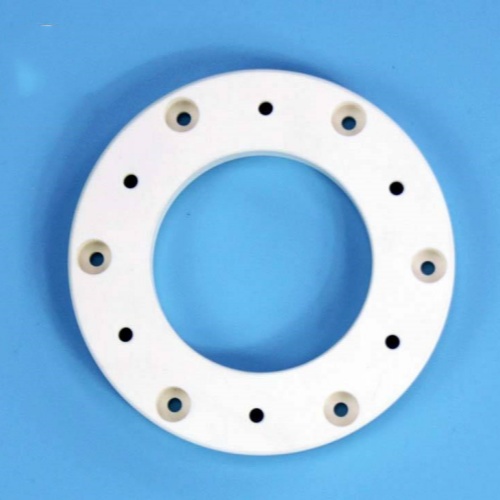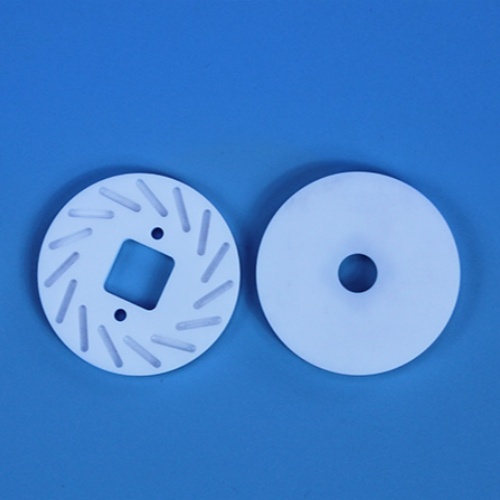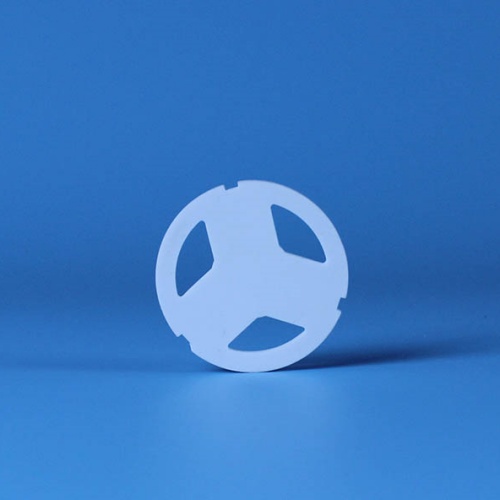What are the performance advantages of ceramic flanges
With the continuous development of industrial technology, the performance requirements of pipeline connectors are getting higher and higher. Ceramic flanges stand out among many materials due to their unique performance advantages, making them an ideal choice for some special working conditions. So what are the performance advantages of ceramic flanges?
I, high hardness and wear resistance
Ceramic materials themselves have extremely high hardness. For example, the Rockwell hardness of alumina ceramics can reach HRA 80-90, and the hardness of silicon nitride ceramics is as high as HRC 92. This high hardness gives ceramic flanges excellent wear resistance. According to professional research institutions, its wear resistance is equivalent to 266 times that of manganese steel and 171.5 times that of high-chromium cast iron. In practical applications, such as pipeline transportation in the chemical and petroleum industries, fluid media containing solid particles are often encountered, and these particles will cause strong wear on pipes and connectors.
The ceramic flange can effectively resist this kind of wear and tear. According to years of customer follow-up surveys, under the same working conditions, its service life can be extended by more than ten times compared with traditional metal flanges, which greatly reduces the maintenance and replacement costs of equipment.

II, excellent high temperature resistance
Ceramic flanges can withstand extremely high temperatures, and alumina ceramics and zirconia ceramic parts can be used in high temperature environments of 1050-1750 ° C for a long time. In some high-temperature industrial fields, such as thermal power generation, heat treatment, aerospace, etc., equipment often needs to operate under high temperature conditions.
Traditional metal flanges may experience strength loss, deformation, or even damage in this high-temperature environment, while ceramic flanges, with their high melting point and good high-temperature stability, can maintain stable mechanical properties under high-temperature conditions, ensuring the normal operation of the equipment and preventing the failure of the entire system due to flange damage, thus improving the safety and reliability of the equipment.
III. Excellent corrosion resistance
Ceramic materials generally do not rust, are not afraid of oxidation, and have strong resistance to acid and alkali corrosion. In the chemical, pharmaceutical, food and other industries, pipes often transport various acids, alkalis, salts and other corrosive media. These media can cause serious corrosion to metal flanges, shorten their service life, and may even lead to leakage accidents, bringing safety hazards and economic losses. Ceramic flanges can resist the erosion of these chemical media, and can be used normally in acid and alkali corrosive environments, effectively protecting the integrity of the pipeline system, reducing the frequency of maintenance and replacement due to corrosion, and reducing the operating costs of enterprises.

IV, good insulation properties
Ceramic materials have excellent electrical insulation properties. For example, the breakdown voltage of alumina ceramics can reach 1mm 15KV. In industries with high insulation performance requirements such as power and electronics, the use of ceramic flanges can effectively prevent the passage of current and avoid the occurrence of electrochemical corrosion. At the same time, in some complex electromagnetic environments, ceramic flanges will not be disturbed by magnetic fields and will not generate magnetism, which can ensure the normal operation of equipment.
For example, in the insulator connection of high-voltage transmission lines and the piping system of electronic equipment, the insulation performance of ceramic flanges can ensure the safe and stable operation of the system, preventing short circuits, leakage and other accidents caused by poor insulation.
V. Light weight
The density of ceramic flanges is relatively small, generally 3.7 – 3.95g/cm ³, which is only half that of steel. In some large equipment or equipment that needs to be moved frequently, the use of ceramic flanges can greatly reduce the load of the equipment. This not only facilitates the installation, transportation and maintenance of the equipment, but also reduces the requirements of the equipment on the support structure, reduces the overall weight and volume of the equipment, and improves the flexibility and mobility of the equipment.
For example, in the aerospace industry, reducing the weight of equipment is of great significance for improving flight performance and reducing energy consumption. The application of ceramic flanges can effectively achieve weight reduction goals without affecting the strength and performance of equipment.
VI. Good sealing performance
The sealing performance of ceramic flanges is very good, which can effectively prevent medium leakage. Its surface is smooth and flat, and after precision machining, it can be closely fitted with sealing components such as sealing gaskets to form a good sealing effect. In the chemical, oil, natural gas and other industries, the medium transported by pipelines is often flammable, explosive, toxic and other hazards. Once leakage occurs, the consequences are unimaginable. The excellent sealing performance of ceramic flanges can reduce the occurrence of leakage accidents, improve the safety and environmental protection performance of equipment, and ensure the safety and reliability of the production process.

VII. High mechanical strength
Although ceramic materials are generally considered to be relatively brittle, modern ceramic flanges already have high mechanical strength through advanced manufacturing processes and material optimization. For example, alumina ceramics have high flexural strength and toughness, and can withstand certain mechanical loads and thermal shocks. In industrial applications, ceramic flanges can maintain structural stability under harsh environments such as high temperature and high pressure, and will not be easily damaged by external forces, thus prolonging the service life of equipment and improving the operating efficiency of equipment.
VIII.No pollution
Ceramic flanges will not contaminate the transported medium during use. In the food, medicine and other industries, the quality and safety of products are of paramount importance. Any possible source of contamination may lead to substandard products and even endanger the health of consumers. Ceramic materials themselves are chemically stable and will not chemically react with the medium or release harmful substances. Therefore, the piping system connected with ceramic flanges can ensure the purity of the medium and meet the strict hygiene and Quality Standards of the food, medicine and other industries.
VIIII, thermal shock resistance
Some ceramic materials such as zirconia ceramics have good thermal shock resistance. In some cases of severe temperature changes, such as rapid heating or cooling, the performance advantage of ceramic flanges.
PREVIOUS:Working principle of ceramic injection pump
NEXT:What are the differences between zirconia ceramics and alumina ceramics
CATEGORIES
LATEST NEWS
- Petrochemical ceramic injec...
- Zirconia Ceramic Rod Custom...
- High-temperature resistance...
- What is the wear resistance...
- What is the hardness of cer...
- Aluminum oxide ceramic cust...
- What are the main aspects o...
- What are the mechanical pro...
- Thermal properties of zirco...
- What properties should be c...
